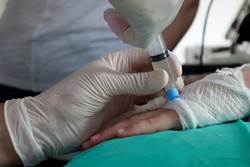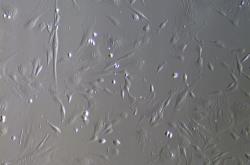You are here
First in West: MSC from Cord Tissue used to treat Graft-versus-Host Disease

Graft-versus-Host Disease (GvHD) is a common and serious complication following a stem cell transplant from an unrelated donor. GvHD is divided into acute and chronic form according to the clinical course and time of the diagnosis. It is a life-threatening condition, which contributes greatly to early mortality after stem cell transplants. Survivors may suffer organ damage and have impaired quality of life.
The first line of prevention and treatment for GvHD is steroids. When GvHD does not respond to steroids or is not resolved by steroids it is said to be "steroid-refractory". In this situation there are many second-line therapies, but none of them is considered to be clearly superior and most effective.
Mesenchymal stem cells (MSC), because of their unique immune properties, have great potential as a treatment option for steroid-refractory GvHD. One attribute of MSC is that donor and patient do not have to be matched, so that MSC can easily be supplied from a bank of donations. Another helpful attribute is that many studies show MSC tend to suppress auto-immune reactions and thus potentially could suppress the conflict between graft and host immune systems. Moreover, MSC can be supplied intravenously, which is highly convenient for the patient.
In this article we report on a series of patients treated for GvHD in Poland with MSC from the Wharton's jelly in cord tissue (WJ-MSC). Wharton's jelly is an abundant source of MSC with several advantages: harvesting cord tissue is non-invasive and MSC are easily isolated, and the MSC from cord tissue have good proliferation and differentiation capabilities.
Polski Bank Komórek Macierzystych S.A. (PBKM) is the largest family cord blood bank in Poland and is the leader of an EU network of banks called "Famicord Group". In parallel to their commercial activity, PBKM runs a public bank of cord blood and cord tissue with inventory of over 3000 units funded by PBKM and the Polish Ministry of Health. PBKM is one of the eight European private stem cell banks having AABB accreditation. PBKM has supplied stem cells for 34 therapies to date (18 of cord blood and 16 of MSC from Wharton's Jelly).
Ten GvHD patients were treated in the years 2011-2013 at four different clinics in Poland. They underwent treatment with MSC derived from Wharton's jelly as a salvage therapy for GvHD. Each application was preceded by bioethical committee approval. The patient ages ranged from 3 to 20 years. Among them were three people with extensive chronic GvHD and seven with acute GvHD, including six patients with grade IV and one with grade III.
The patients had originally received stem cell transplants due to the following underlying diseases: acute lymphoblastic leukemia (ALL), acute myeloid leukemia (AML), myelodysplasia syndrome (MDS) transformed into AML, MDS, severe aplastic anemia and non-Hodgkin lymphoma. All patients failed to respond to the first-line GvHD therapy with steroids and had unsatisfactory response to the second-line therapies including: cyclosporine A, mycophenolate mofetil, tacrolimus, antithymocyte globulin, etanercept, intravenous immunoglobulin, extracorporeal photopheresis and monoclonal antibodies.

The GvHD patients received 1-3 intravenous infusions of WJ-MSC from a few third-party donors within a 1-2 week interval. They received a median overall dose of 1.5 million cells per kg of body weight. The Wharton's Jelly was isolated by mechanical dissection of collected umbilical cords, then plastic-adherent cells (MSC) were isolated without enzymatic treatment, cultured, and cryopreserved in liquid nitrogen. The laboratory processing took place in a GMP ISO 5 environment. Reference samples of MSC were used to check cell count, viability, and immunophenotype. The MSC were administered immediately after thawing.
The patients were monitored for adverse effects during the infusion and follow-up period. The median time of observation equaled 9.5 months. No adverse effects were described during or after WJ-MSC application apart from transient tachycardia that subsided without intervention.
Six of the ten GvHD patients responded to the therapy and their doses of immunosuppressive treatment could be reduced, including one with chronic GvHD who showed improvement 3 months after MSC application. Two patients showed complete response and were cleared of GvHD symptoms. The first cleared patient was 7-year-old girl with grade IV intestinal acute GvHD who had been transplanted for ALL in second remission. The second cleared patient was a 3-year-old boy with grade IV skin and intestinal acute GvHD who suffered from MDS that transformed to AML. Both of these cleared patients had received MSC treatment early after GvHD diagnosis. Out of four remaining patients who responded to therapy, two of them have limited chronic GvHD (previously was extensive), and one died 3 months after MSC infusion due to central nervous bleeding and sudden cardiac arrest. The last one is currently being evaluated, however 1 month after MSC treatment the patient's GvHD severity grade decreased from IV to I.
Among the four of ten patients who did not respond to the therapy, one is stable with chronic extensive GvHD and the other three died: two because of GvHD progression and sepsis, and one (with grade IV acute GvHD with skin, intestinal and hepatic involvement) due to hepatic coma. No relapses or de novo malignancies occurred during the follow-up period.
The application of WJ-derived MSC from third party donors is a safe procedure that brings clinical effects even when administered as a salvage therapy. In more than half of these patients, WJ-MSC infusion ameliorated symptoms of GvHD and allowed them to reduce immunosuppressive treatment. In one fifth of the patients, the WJ-MSC therapy led to disappearance of GvHD symptoms. Outcomes seemed to be improved when the time between diagnosis and MSC infusion was shorter.
Nowadays, MSC are officially considered as a second-line treatment for acute GvHD. However, further studies are needed to establish infusion timing, optimal cell doses, as well as number of injections and intervals between them. These cases were published in an abstract book of the 40th Annual Meeting of the European Group for Blood and Marrow Transplantation. (see below)
Reference
The First in Poland Follow-Up of 10 Patients with Steroid-Refractory Graft-versus-Host Disease Treated with Intravenously Applied Wharton's Jelly-derived Mesenchymal Stem Cells as a Salvage Therapy. Abstract PH-AB232. Bone Marrow Transplant. 2014 Mar;49:S537.
D. Gladysz1, M. Murzyn1, I. Czaplicka1, A. Olkowicz1, T. Oldak1, M. Mielcarek2, K. Kalwak2, K. Drabko3, J. Styczynski4, K. Pawelec5, M. Boruczkowski6, J. Baran1, & D. Boruczkowski1
- Medical Department, The Polish Stem Cell Bank, Warszawa, Poland
- Department of Bone Marrow Transplantation, Paediatric Oncology and Haematology, Wroclaw Medical University, Wroclaw, Poland
- Department of Paediatric Haematology, Oncology and Transplantology, Medical University, Lublin, Poland
- Collegium Medicum, Nicolaus Copernicus University, Bydgoszcz, Poland
- Department of Paediatrics, Haematology and Oncology, Medical University, Warszawa, Poland
- Department of Immunology, Poznan University of Medical Sciences, Poznan, Poland



 Polski Bank Komórek Macierzystych S.A. (
Polski Bank Komórek Macierzystych S.A. (